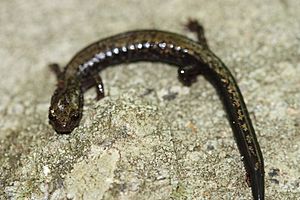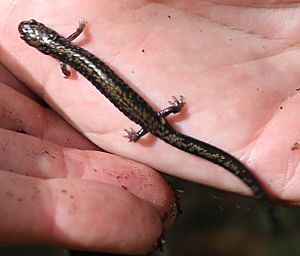Peaks of Otter salamander facts for kids
Quick facts for kids Peaks of Otter salamander |
|
|---|---|
 |
|
| Conservation status | |
| Scientific classification | |
| Genus: |
Plethodon
|
| Species: |
hubrichti
|
The Peaks of Otter salamander (Plethodon hubrichti) is a special type of salamander. It belongs to a family called Plethodontidae. This salamander is found only in one small area. This area is the Peaks of Otter in the Blue Ridge Mountains of Virginia.
Contents
Meet the Peaks of Otter Salamander
This salamander is dark brown. It has shiny, brassy spots all over its back and sides. Sometimes, it might also have a few white speckles. Its belly is plain grey, not spotted. Male salamanders have a small gland under their chin.
The Peaks of Otter salamander looks a bit like the Cheat Mountain salamander (P. nettingi). But you can tell them apart! The Peaks of Otter salamander has more metallic spots. It also usually has 19 grooves on its sides, while the Cheat Mountain salamander has 17 to 19. When they are born, these salamanders are dark grey. The brassy spots appear later, when they grow to about 25 millimeters long.
How the Peaks of Otter Salamander Got Its Name
The story of this salamander's name began in 1949. A man named Leslie Hubricht was a typewriter salesman. But he also loved collecting land snails! He often found salamanders in the same places as snails. He would send any unusual salamanders he found to museums.
Some salamanders he collected in Virginia were thought to be P. nettingi. This would have been a big surprise! That type of salamander was only known from West Virginia. Two other scientists, Richard Hoffman and Richard Highton, looked at these salamanders. They thought it might be a brand new species.
Hoffman and Highton found where Hubricht had collected the salamanders. They gathered 24 more. They were sure it was a new species! They even gave it a name, P. aureolus. But this name was never officially used.
Before they could publish their discovery, Highton called Gordon Thurow. Thurow was the scientist who first misidentified the salamanders. Highton told him about the new species. What Highton didn't know was that Thurow then rushed to the collection site himself! Thurow quickly gathered his own specimens. He then published his own description of the new species first. He named it P. hubrichti, after Leslie Hubricht. This rush to be first made Richard Hoffman decide to study other animals instead, like millipedes!
Where Do They Live?
The Peaks of Otter salamander lives in a small area. It's about 19 kilometers long. This area is along the Blue Ridge Parkway. It's in the Peaks of Otter part of the Blue Ridge Mountains. You can find them in Bedford, Botetourt, and Rockbridge Counties in Virginia.
These salamanders live on the forest floor. They are usually found at high places, above 845 meters (about 2,772 feet).
Why They Live High Up
The Peaks of Otter salamander is a mountain species. It is very sensitive to changes in its home. They don't do well in warmer, drier places. This is why they stick to higher elevations.
Scientists studied these salamanders between 2008 and 2010. They found that fewer salamanders lived at lower elevations. This was because of warmer temperatures and less moisture. These conditions make it hard for the salamanders to survive.
Understanding why they live in such a small area helps protect them. At their best elevations, these salamanders are very common. Even when some trees were cut (called "shelterwood cuts"), their numbers stayed strong. But if trees were cut at lower elevations, it could harm them. Opening the forest canopy makes it hotter and drier. This could be too much for the salamanders. So, it's important to protect the old, healthy forests. Especially in the lower parts of their range.
Reproduction and Life Cycle
Scientists first saw a Peaks of Otter salamander nest in 2005. It was found under a rock. About 10 eggs, each 5.5 millimeters wide, were hanging from the soil. The mother salamander was guarding them. After about 42 to 48 days, tiny salamander embryos with eyes could be seen in the eggs. Sixteen days later, the baby salamanders hatched!
A female salamander can lay between 1 and 12 eggs. On average, they lay about 8 or 9 eggs. Females at higher elevations tend to lay more eggs. But a higher percentage of females at lower elevations were carrying eggs. This means that while high-elevation females lay more eggs each time, low-elevation females might reproduce more often.
Salamander Life and Habits
The Peaks of Otter salamander has a very small home range. But in that small area, there can be many of them! Because their range is so limited, they are easily threatened. Any changes to their forest home can be very harmful. A single salamander usually only moves about 1 meter (about 3 feet). So, if their habitat is changed, it can split up their groups. This makes it harder for them to survive long-term.
Adult and young salamanders mostly hide under rocks and logs. They protect these spots from other salamanders. Baby salamanders are often found in the leaf litter. Young salamanders grow about 0.10 millimeters per day.
These salamanders are most active at night. They like to be out between 8 PM and midnight. They are especially active after it rains. This is because they need moist skin to breathe. When it's dry, they hide underground. They eat small bugs that live on the surface. If it hasn't rained for a long time, more salamanders might come out after a rainfall. They are hungry and need to find food!
The Peaks of Otter salamander is different from the widespread red-backed salamander (P. cinereus). The red-backed salamander can live in many temperatures. But the Peaks of Otter salamander can handle colder temperatures better. However, it gets dehydrated faster. This is why it needs to stay in higher, cooler, and moister places. They are not good at controlling their own body temperature. So, they rely on being active at night, burrowing, and hiding under rocks and logs. This helps them find the best temperature and moisture.
Living Together: Salamander Communities
Sometimes, different animal species compete for food or space. This can affect how many animals live in an area. The red-backed salamander (P. cinereus) lives all around the Peaks of Otter salamander's home. Scientists thought that competition between these two might limit where the Peaks of Otter salamander can live.
These two salamander species are related. They are also similar in size. They both hunt at night when it's humid. They prefer soft-bodied prey. Both also defend their small home areas.
When the Peaks of Otter salamander lives alone, there are many of them. But when it lives in the same area as the red-backed salamander, its numbers are lower. This suggests they are competing for resources.
The areas where both salamanders live together don't change much. Even after 10 years in an undisturbed forest, the numbers stayed steady. The Peaks of Otter salamander made up about 60-70% of the salamanders found. However, some of these shared areas are in places where trees are cut. This might affect the balance between the two species.
Salamanders like the Peaks of Otter salamander are very important! They help control the number of small bugs in the forest. They also help store nutrients in the ecosystem. Because they are so important and sensitive to changes, their health tells us a lot about the overall health of the forest.
Protecting the Peaks of Otter Salamander
The USDA Forest Service considers the Peaks of Otter salamander a "Sensitive Species." This is because it lives in such a small area. It doesn't have special legal protection yet.
Where it lives, this salamander can do very well if its home is not disturbed. But activities that change the forest, like cutting down trees, can harm it. Scientists have studied how tree cutting affects these salamanders.
Lungless salamanders need moist skin to breathe. So, they need moist places to live. Cutting down trees can make the forest drier. It can also affect their food. Peaks of Otter salamanders eat more soft-bodied bugs in old, healthy forests. These bugs are better food. A diet rich in these bugs means a healthier habitat.
Short-Term Effects of Tree Cutting
Scientists studied the short-term effects of tree cutting. They used 12 sites. Four sites had all trees removed (clearcut). Four had some trees removed (shelterwood). Four had no trees removed (reference). They counted salamanders before and after.
In the shelterwood and reference sites, salamander numbers stayed steady. But in the clearcut sites, salamander numbers dropped a lot. Two years after clearcutting, only 30% of the salamanders were left! This was likely due to salamanders moving away or dying.
Also, fewer young salamanders were found in clearcut and shelterwood sites. This is because young salamanders are more sensitive to losing shade and moisture. Clearcutting clearly hurt the salamander populations in the short term. Because of this, the George Washington and Jefferson National Forest Service no longer allows clearcutting.
Long-Term Effects of Tree Cutting
A 12-year study looked at the long-term effects. Two years after clearcutting, salamander numbers were only 25% of what they were before. The population didn't start to recover until five years later. Even after 12 years, they only reached 55% of their original numbers. Shelterwood cuts did not cause significant long-term harm.
Salamanders usually don't move far from their homes. But after clearcutting, some salamanders moved to nearby undisturbed areas. We don't know if they can survive in these new places.
Long-term studies help us understand normal changes in populations. Even in undisturbed areas, salamander numbers go up and down. But clearcutting clearly has a big negative impact. There were no signs of full recovery even after 12 years. Shelterwood cuts are not as harmful. They might be used carefully in areas where the salamander populations are stable.
Scientists think that clearcutting could make the forest hotter and drier. This might favor the red-backed salamander, which can handle these conditions better. This could be a problem for the Peaks of Otter salamander in areas where both species live.



